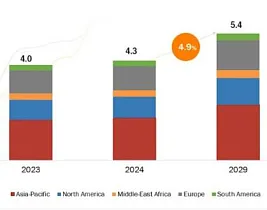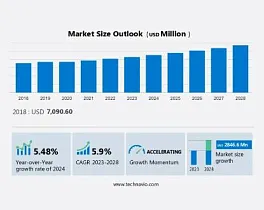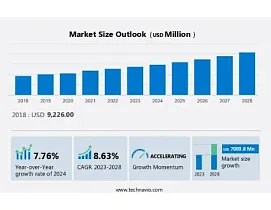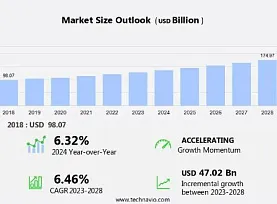


The market is transforming with IoT-enabled HVAC systems enhancing the efficiency of HVAC systems and reducing energy wastage. These systems, integrated into smart homes and offices, leverage smart building automation technologies for occupant detection and energy consumption reduction. Despite technical complexities in implementing HVAC systems, residential buyers and industrial and residential businesses are adopting these technologies. The market caters to the food and petrochemical industries, storage and warehouse facilities, and processing and storage industries, addressing temperature and humidity needs. With the rise in urban population and commercial construction, the demand for advanced heat ventilation and sensing devices is escalating, driven by the Internet of Things (IoT). Our researchers studied the market research and growth data for years, with 2023 as the base year and 2024 as the estimated year, and presented the key drivers, trends, and challenges for the market.
There is increasing growth due to the increasing adoption of smart and connected HVAC systems. One of the key reasons is the advancement in portable devices and monitoring systems such that end-users can manage their systems in a much more convenient and efficient way. Additionally, there is an increasing demand for IoT-enabled devices as these devices are used to solve complex maintenance tasks in residential and commercial HVAC systems.
Also, several system manufacturers are collaborating with startups and IoT solution providers in a bid to strengthen their offerings. For example, in June 2022, Midea Group Co., Ltd. (Midea) partnered with Taqeef Refrigeration and Air Condition Trading LLC (Taqeef), a UAE-based AC and cooling solutions provider, to offer the company's V8 Series with variable refrigerant flow rate (VRF) in the UAE, to unveil a new blueprint for developing intelligent solutions that deliver the highest energy efficiency and comfort in the industry. Hence such factors are expected to drive the growth of the global Heating, ventilation, and air conditioning (HVAC) Control Systems market during the forecast period.
Factors such as the demand for reducing operational and maintenance costs, as well as optimizing energy use in commercial and residential buildings, are increasing, resulting in advances in lighting, cooling, heating, and ventilation systems, which account for about 60% of energy consumption in buildings.
Therefore, advances such as the integration of two or more systems help to optimize energy efficiency in buildings. For example, the integration of lighting systems and HVAC systems in buildings under a single platform minimizes energy consumption and improves the efficiency of building management systems. Thus, such integration helps in regulating the internal building environment in terms of temperature, humidity, and light. Hence, such integration is expected to drive the growth of the Market during the forecast period.
As there is increasing adoption of technological advances in HVAC systems, such as wireless technologies and connectivity features, is growing rapidly across the residential, commercial, and industrial segments, it poses a significant threat to the manufacturers in terms of making these safe from cybersecurity threats.
Most of the systems, such as Wi-Fi-based thermostats, temperature sensors, relative humidity sensors, and flow sensors, are vulnerable to hacking. Hence, cyber security threats pose a significant challenge to the global market which can negatively impact the market growth during the forecast period.
The sensors segment will account for a major share of the market's growth during the forecast period. One of the key applications of sensors in HVAC is to measure and detect changes in temperature, humidity, and airflow. Also, these sensors act as communication media between HVAC systems and end-users. Some of the types of sensors in HVAC systems include temperature sensors, relative humidity sensors, flow sensors, pressure sensors, and electric sensors.
The sensors segment was valued at USD 7.76 billion in 2018. There is an increase in investments in research and development by several companies to enhance temperature sensor functionalities. For instance, many of them have started equipping independent temperature sensor systems in place of thermostats. Thus, such type of sensors facilitates these to automatically power off if the room is unoccupied or adjust the temperature based on the change in room temperature. Thus, these types of sensors have started replacing thermostats, especially in commercial buildings, making them obsolete. Hence such applications in commercial and residential buildings are expected to drive the growth of the global market during the forecast period.
Key market players include ABB Ltd., Acuity Brands Inc., Azbil Corp., Computime Group Ltd., Delta Electronics Inc., Emerson Electric Co., Fr. Sauter AG, Generac Holdings Inc., Honeywell International Inc., Johnson Controls International Plc., KMC Controls Inc., Lennox International Inc., Mass Electronics Pty Ltd., Mitsubishi Electric Corp., NanoSense, Quest Controls Inc., Reliable Controls Corp., Schneider Electric SE, Siemens AG, and Trane Technologies plc.



